The ASUS Vivobook Pro 15 OLED Review: For The Creator In All Of Us
by Brett Howse on March 7, 2022 8:30 AM ESTSystem Performance
The M3500 version of the ASUS Vivobook Pro 15 comes in two choices of AMD H-Series processors with the 6-Core Ryzen 5 5600H, which offers twelve threads and a 4.2 GHz maximum boost frequency, or the Ryzen 7 5800H which bumps up to eight cores, sixteen threads, and a 4.4 GHz maximum frequency. The system is offered with 16 GB of RAM that is soldered in, and up to a 1 TB SSD.
On the graphics side, ASUS offers the NVIDIA RTX 3050 with Studio drivers. ASUS sent us this device prior to the Ryzen 6000 launch, but Ryzen 6000 and Ryzen 5000 both feature a Zen 3 CPU core and the big change with Ryzen 6000 is RDNA2 graphics, rather than Vega. Since the Vivobook Pro features a much more powerful dedicated graphics card the integrated graphics change is not as significant on this device.
Ryzen 5000 “Cezanne” has been a fantastic platform for AMD, offering great CPU performance and excellent power efficiency.
To see how the Vivobook Pro 15 performs it was run through our standard laptop test suite. Sadly we have not had a lot of comparable systems in to test over the last year, with perhaps the Microsoft Surface Laptop Studio – at least on performance – being the most similar. The Laptop Studio has a slightly more powerful GPU in the RTX 3050 Ti, but only has a quad-core Tiger Lake H35 CPU so it will be interesting to see how it compares to the 16-thread Ryzen 7 5800H. Several systems with lower power 15-Watt chips are also included in the graphs to give a feel for where this entry-level content creator notebook fits in compared to more portable devices. As always, if you would like to compare any system we have ever reviewed, all of the data is in the online Bench tool.
PCMark 10
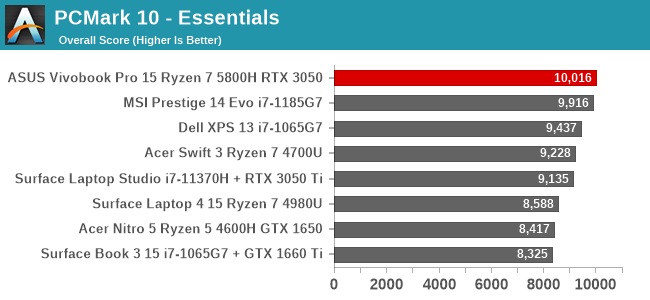
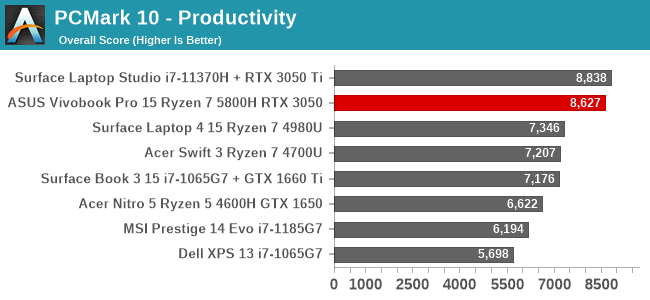
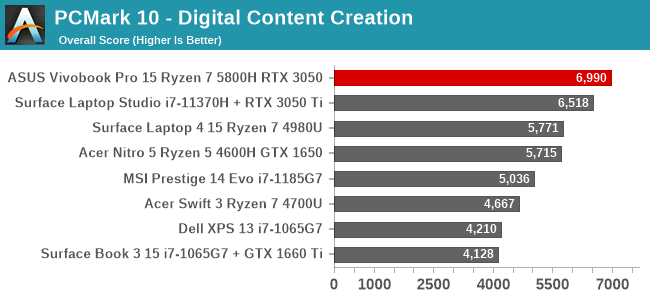
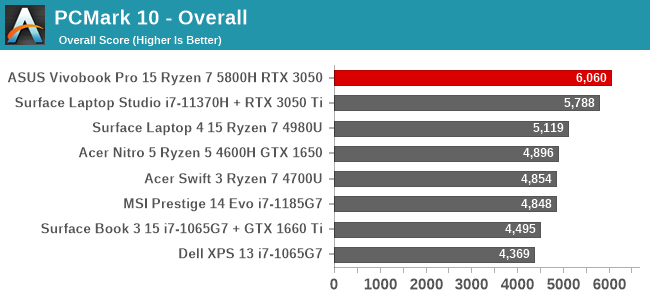
UL’s PCMark 10 suite is a comprehensive system test which offers a variety of workloads to stress different parts of the system including CPU, graphics, and storage. The Vivobook Pro 15 performs very well here thanks to the RTX 3050 and strong Ryzen CPU and tops this comparison.
Cinebench
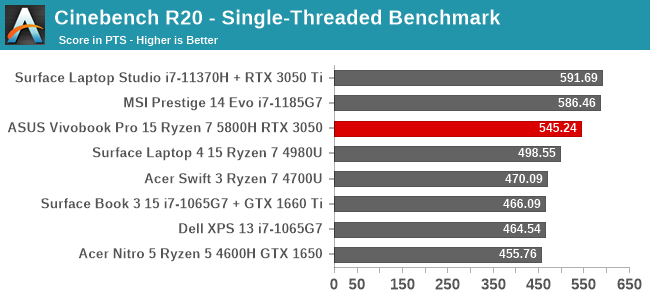
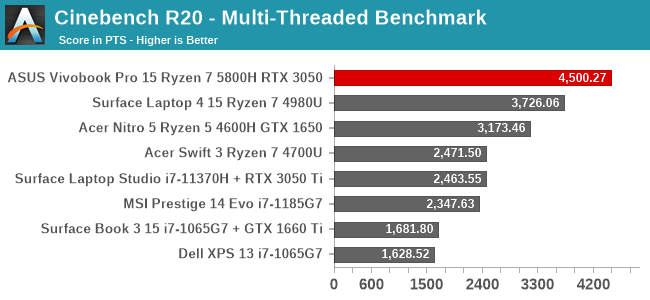
With sixteen threads, the Vivobook Pro’s Ryzen processor does very well on the CPU-focused Cinebench test. Zen 3 is slightly behind Intel’s Tiger Lake in terms of single-threaded performance but the extra CPU cores shine in the multi-threaded variant of this benchmark.
Handbrake
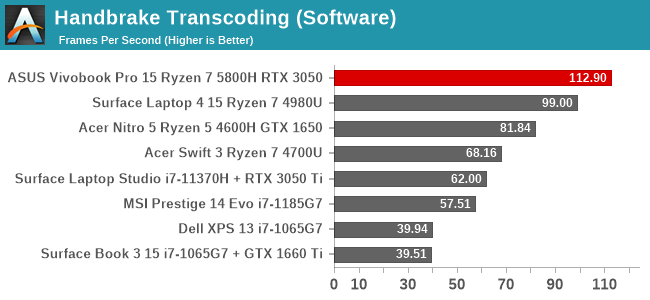
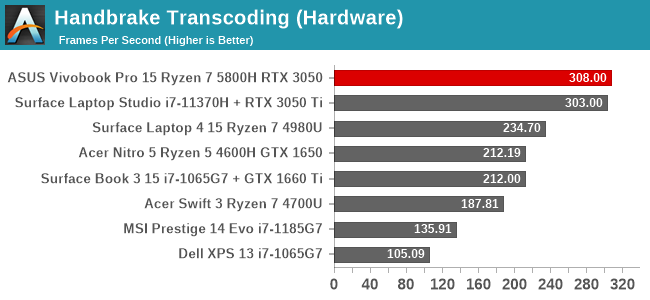
AMD’s Ryzen 7 also does very well in our transcoding benchmark. The extra CPU threads put it at the top of the software transcoding test, and the dedicated RTX 3050 graphics allow for extremely quick transcoding in hardware using the NVENC option in Handbrake.
7-Zip

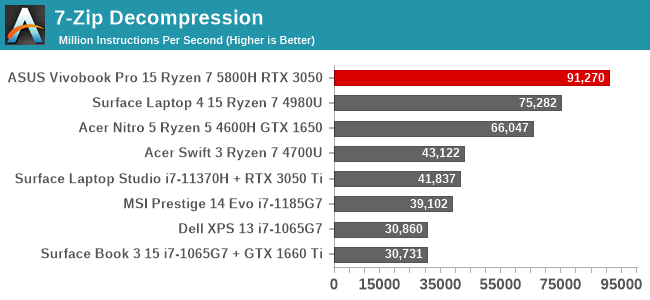
The open-source 7-Zip file compression tool includes a built-in benchmark which tests compression and decompression speeds. The Ryzen 7 5800H does very well here as the tool is able to take advantage of the extra CPU cores during this test.
Web Tests
Web performance is tied not only to the CPU and its ability to quickly ramp up to its maximum frequency, but also is heavily impacted by the underlying web browser’s scripting engine and its efficiency. As such we ensure all of the systems are tested with the Chromium Edge browser built into Windows 10. Browser performance does change over time with updates though as the browsers are updated.
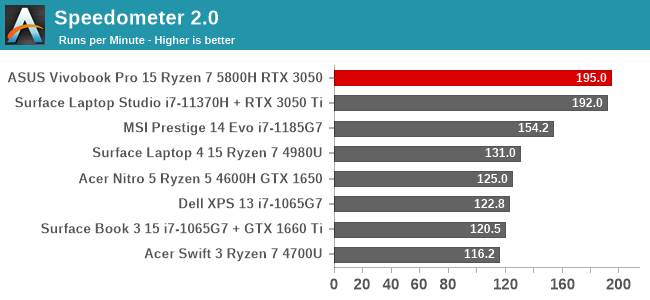

The Ryzen 7 5800H does very well, edging the H35 Tiger Lake platform in the Surface Laptop Studio in the Speedometer 2.0 test, and really stretching its legs on WebXPRT 3. As a note, WebXPRT 4 is now officially live, so we will be transitioning to it over the next several reviews.
Storage Performance
AMD’s Ryzen 5000 series does not support PCIe 4.0 for storage unlike Intel’s Tiger Lake platform so for SSD the device is limited to PCIe 3.0 x4. ASUS shipped the review unit with a SK Hynix BC711 drive which is a low-power version the 4D 128-layer M.2 2280 drive from SK Hynix.
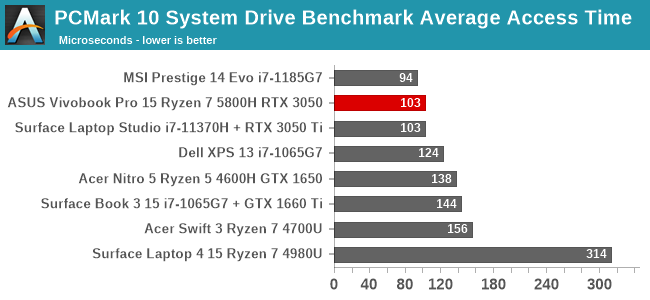
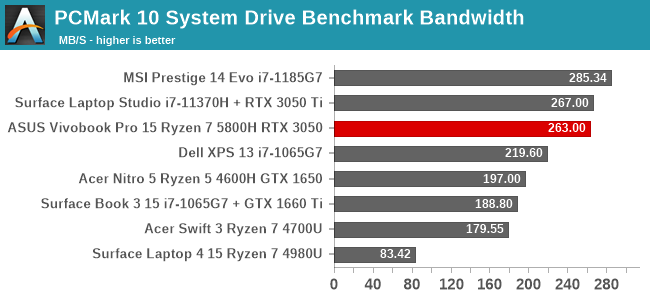
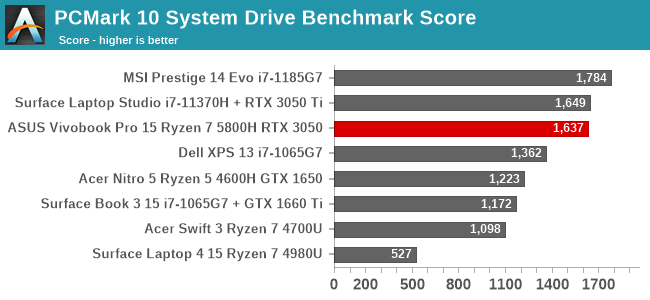
Performance from this drive was excellent. Despite not being PCIe 4.0, it still proved to be one of the quickest drives we have tested in the PCMark storage test suite, which utilizes real-world storage traces.











33 Comments
View All Comments
eek2121 - Monday, March 7, 2022 - link
Seems they didn't really try with higher end configurations. My Razer Blade 14 is slightly heavier at 3.94lbs, but beats this thing in everything except the OLED screen (though the refresh rate and resolution on the Razer Blade is much higher).matagyula - Monday, March 7, 2022 - link
I think it is worth pointing out that that Razer Blade 14 costs twice as much as the unit reviewed.Alistair - Monday, March 7, 2022 - link
so your laptop costs twice as much, is missing the main feature, the OLED screren, and it is miraculously faster? amazing stuff... /sbrucethemoose - Monday, March 7, 2022 - link
This isn't really a high performance gaming laptop. Asus has a compact ROG lineup to compete with the Blade more directly.relux - Monday, March 7, 2022 - link
While OLED screens are a boon for content consumption on mobile devices like phones, these smaller panels have advantages in high color accuracy, high brightness, high quality, etc. The review outright uses the word “terrible” to describe the accuracy of the display on this laptop. Windows has more static user interface elements than Android or iOS, creating greater risk of burn-in. OLED screens also tend to “smear” when pixels need to change from dark to light quickly, and this would surely be unpleasant in games or movies, and more noticeable on a larger screen. I’m left wondering, if the display is merely less accurate, more prone to degradation, and has unimpressive brightness to boot, why wouldn’t consumers prefer a quality LCD which will at the very least have better longevity?Doug_S - Monday, March 7, 2022 - link
Where do you get this idea that OLED pixels have problems changing brightness quickly? That's an LCD problem, OLED has no issue at all in that respect.itsAdamS - Tuesday, March 8, 2022 - link
Often the pixels on an OLED are turned off entirely when displaying black, and there's a delay to switch them back on again, greater than LCD response time, that leads to black smearing. I certainly notice this on my phone when scrolling something black but I haven't noticed this at all on my Asus OLED laptop -- they obviously chose response time over battery life and don't turn the pixels off completely.Doug_S - Tuesday, March 8, 2022 - link
That's not true at all. What you observe has nothing to do with response time, but a mismatch of screen updates and refresh rate.Oxford Guy - Sunday, March 13, 2022 - link
There is no laptop LCD with this much static contrast. So, define ‘quality’.If VA panels begin to appear then OLED might have some competition.
pjcamp - Monday, March 7, 2022 - link
You could do us a solid favor if you added two things to all your laptop reviews.1. Does it use proprietary peripherals? I never would have purchased a Dell XPS 13 had I known in advance that if you forget your Genuine Dell Charger, you're screwed. It refuses to charge without one.
2. See if Linux will install on it.